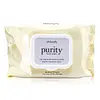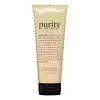What's inside
What's inside
 Key Ingredients
Key Ingredients

No key ingredients
 Benefits
Benefits

 Concerns
Concerns

 Ingredients Side-by-side
Ingredients Side-by-side

Water
Skin ConditioningButylene Glycol
HumectantSodium Citrate
BufferingGluconolactone
Skin ConditioningCetearyl Isononanoate
EmollientCeteareth-20
CleansingCetearyl Alcohol
EmollientPhenoxyethanol
PreservativeSodium Benzoate
MaskingGlycerin
HumectantGlyceryl Stearate
EmollientBenzoic Acid
MaskingCeteareth-12
EmulsifyingCetyl Palmitate
EmollientEthylhexylglycerin
Skin ConditioningParfum
MaskingLinalool
PerfumingCalcium Gluconate
HumectantGeraniol
PerfumingSodium Hydroxide
BufferingLimnanthes Alba Seed Oil
Skin ConditioningTocopherol
AntioxidantWater, Butylene Glycol, Sodium Citrate, Gluconolactone, Cetearyl Isononanoate, Ceteareth-20, Cetearyl Alcohol, Phenoxyethanol, Sodium Benzoate, Glycerin, Glyceryl Stearate, Benzoic Acid, Ceteareth-12, Cetyl Palmitate, Ethylhexylglycerin, Parfum, Linalool, Calcium Gluconate, Geraniol, Sodium Hydroxide, Limnanthes Alba Seed Oil, Tocopherol
Water
Skin ConditioningSodium Trideceth Sulfate
CleansingDisodium Lauroamphodiacetate
CleansingAcrylates Copolymer
Polysorbate 20
EmulsifyingSodium C14-16 Olefin Sulfonate
CleansingGlycerin
HumectantCocamidopropyl Betaine
CleansingIsopropyl Alcohol
SolventSodium Sulfate
Limnanthes Alba Seed Oil
Skin ConditioningAniba Rosaeodora Wood Oil
AstringentPelargonium Graveolens Flower Oil
MaskingBulnesia Sarmientoi Wood Oil
MaskingCymbopogon Martini Oil
MaskingRosa Centifolia Flower Oil
MaskingAmyris Balsamifera Bark Oil
MaskingSantalum Album Oil
MaskingSalvia Sclarea Oil
MaskingOrmenis Multicaulis Oil
MaskingAcacia Dealbata Flower/Stem Extract
Skin ConditioningDaucus Carota Sativa Seed Oil
EmollientPiper Nigrum Fruit Oil
MaskingDisteareth-75 Ipdi
Glycereth-7 Caprylate/Caprate
EmulsifyingPotassium Chloride
Hydrogen Peroxide
AntimicrobialMagnesium Nitrate
Magnesium Chloride
Sodium Benzotriazolyl Butylphenol Sulfonate
UV AbsorberButeth-3
SolventTributyl Citrate
SolventSodium Hydroxide
BufferingSodium Chloride
MaskingDisodium EDTA
Citric Acid
BufferingLinalool
PerfumingMethylchloroisothiazolinone
PreservativeMethylisothiazolinone
PreservativeWater, Sodium Trideceth Sulfate, Disodium Lauroamphodiacetate, Acrylates Copolymer, Polysorbate 20, Sodium C14-16 Olefin Sulfonate, Glycerin, Cocamidopropyl Betaine, Isopropyl Alcohol, Sodium Sulfate, Limnanthes Alba Seed Oil, Aniba Rosaeodora Wood Oil, Pelargonium Graveolens Flower Oil, Bulnesia Sarmientoi Wood Oil, Cymbopogon Martini Oil, Rosa Centifolia Flower Oil, Amyris Balsamifera Bark Oil, Santalum Album Oil, Salvia Sclarea Oil, Ormenis Multicaulis Oil, Acacia Dealbata Flower/Stem Extract, Daucus Carota Sativa Seed Oil, Piper Nigrum Fruit Oil, Disteareth-75 Ipdi, Glycereth-7 Caprylate/Caprate, Potassium Chloride, Hydrogen Peroxide, Magnesium Nitrate, Magnesium Chloride, Sodium Benzotriazolyl Butylphenol Sulfonate, Buteth-3, Tributyl Citrate, Sodium Hydroxide, Sodium Chloride, Disodium EDTA, Citric Acid, Linalool, Methylchloroisothiazolinone, Methylisothiazolinone
Ingredients Explained
These ingredients are found in both products.
Ingredients higher up in an ingredient list are typically present in a larger amount.
Glycerin is already naturally found in your skin. It helps moisturize and protect your skin.
A study from 2016 found glycerin to be more effective as a humectant than AHAs and hyaluronic acid.
As a humectant, it helps the skin stay hydrated by pulling moisture to your skin. The low molecular weight of glycerin allows it to pull moisture into the deeper layers of your skin.
Hydrated skin improves your skin barrier; Your skin barrier helps protect against irritants and bacteria.
Glycerin has also been found to have antimicrobial and antiviral properties. Due to these properties, glycerin is often used in wound and burn treatments.
In cosmetics, glycerin is usually derived from plants such as soybean or palm. However, it can also be sourced from animals, such as tallow or animal fat.
This ingredient is organic, colorless, odorless, and non-toxic.
Glycerin is the name for this ingredient in American English. British English uses Glycerol/Glycerine.
Learn more about GlycerinLimnanthes Alba Seed Oil is the oil extracted from the seeds of the meadowfoam plant. This oil is non-fragrant and is an emollient. As an emollient, meadowfoam seed oil helps soften and hydrate the skin.
Meadowfoam seed oil is stable and has a long shelf life due to its chemical structure. It has the highest concentration of stable fatty-acids among plant oils, preventing it from degrading once exposed to oxygen.
Due to the fatty acid content, this ingredient may not be fungal-acne safe.
Meadowfoam is native to California and Oregon.
Learn more about Limnanthes Alba Seed OilLinalool is a fragrance and helps add scent to products. It's derived from common plants such as cinnamon, mint, citrus, and lavender.
Like Limonene, this ingredient oxidizes when exposed to air. Oxidized linalool can cause allergies and skin sensitivity.
This ingredient has a scent that is floral, spicy tropical, and citrus-like.
Learn more about LinaloolSodium Hydroxide is also known as lye or caustic soda. It is used to adjust the pH of products; many ingredients require a specific pH to be effective.
In small amounts, sodium hydroxide is considered safe to use. However, large amounts may cause chemical burns due to its high alkaline.
Your skin has a natural pH and acid mantle. This acid mantle helps prevent harmful bacteria from breaking through. The acid mantle also helps keep your skin hydrated.
"Alkaline" refers to a high pH level. A low pH level would be considered acidic.
Learn more about Sodium HydroxideWater. It's the most common cosmetic ingredient of all. You'll usually see it at the top of ingredient lists, meaning that it makes up the largest part of the product.
So why is it so popular? Water most often acts as a solvent - this means that it helps dissolve other ingredients into the formulation.
You'll also recognize water as that liquid we all need to stay alive. If you see this, drink a glass of water. Stay hydrated!
Learn more about Water